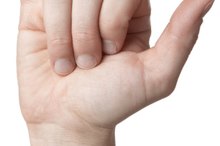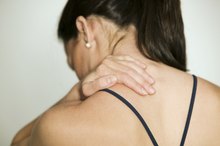Pain in Finger From Golf
You sometimes expect a sore back from a round of golf, or even some discomfort in your shoulders or legs. But a sore finger or fingers can be perplexing, especially if you don’t have arthritis or a pre-existing medical problem with your hands or fingers 1. Of course, arthritis can lead to pain in your fingers, particularly in the joints. But other causes, such as tendonitis or even a fracture, may be at the root of your sore finger.
If you are experiencing serious medical symptoms, seek emergency treatment immediately.
Golf and Arthritis
Arthritis is a condition characterized by inflammation and pain in the joints, but the disease can actually take many different forms. Osteoarthritis, for example, is usually the result of wear and tear on a joint and is commonly observed in the knees of older adults. Rheumatoid arthritis is an auto-immune condition and can strike people in their 30s and 40s. It also often appears in the hands, so the tight grip on a club for a round of golf can leave rheumatoid arthritis sufferers in real pain 1. Psoriatic arthritis is a condition that attacked superstar golfer Phil Mickelson in 2010. Like the disease psoriasis, which attacks healthy skin cells and leaves a painful rash, psoriatic arthritis attacks healthy tissue in the joints. But it is treatable, with a protein-based drug. Other forms of arthritis may be treated by nonsteroidal anti-inflammatory drugs, surgery and even physical therapy.
- Arthritis is a condition characterized by inflammation and pain in the joints, but the disease can actually take many different forms.
- Rheumatoid arthritis is an auto-immune condition and can strike people in their 30s and 40s.
Trigger Finger
Early Signs of Arthritis in Fingers
Learn More
If your pain is isolated primarily in the base of certain fingers after golf, you may be suffering from isolated flexor tendonitis. Your flexor tendons are those that connect the muscles in your forearms to your fingers, and the constant flexing and squeezing of the fingers in sports like golf and tennis can result in flexor tendonitis. Part of the tendon can become inflamed and swollen and a nodule develops around the base of the affected fingers. Commonly affected digits include the ring finger, middle finger and thumb, though any finger can have such problems. Cortisone injections can be helpful, as can resting the hand or using supportive splints.
- If your pain is isolated primarily in the base of certain fingers after golf, you may be suffering from isolated flexor tendonitis.
- Your flexor tendons are those that connect the muscles in your forearms to your fingers, and the constant flexing and squeezing of the fingers in sports like golf and tennis can result in flexor tendonitis.
Hamate Bone Fracture
A fractured hamate bone, often referred to as “golfer’s wrist,” is a common injury because it results from repetitive impacts at the heel of your hand, such as those incurred in playing golf. Though it’s considered a wrist injury, the hamate bone actually originates at the base of the little finger and ring finger, both of which can become quite painful if the condition goes untreated. If you have swelling or tenderness in the wrist and a pain or a loss of feeling in the little finger, you may have golfer’s wrist. A doctor and X-rays can confirm the diagnosis, and a relatively simple surgery can usually solve the problem. You may also need to readjust your grip to reduce the pressure on the heel of that hand.
- A fractured hamate bone, often referred to as “golfer’s wrist,” is a common injury because it results from repetitive impacts at the heel of your hand, such as those incurred in playing golf.
- Though it’s considered a wrist injury, the hamate bone actually originates at the base of the little finger and ring finger, both of which can become quite painful if the condition goes untreated.
Dealing With Pain
What Are Common Causes of Wrist Pain in Basketball Players?
Learn More
If you start to notice pain in your fingers from golf, talk with your local golf pro about your grip and swing. You may be gripping the club too tightly or in a manner that is putting too much pressure on one finger. A pro might have some easy changes you can make. Also, if you consistently have a sore finger or soreness in any body part from golf, tell your doctor and be ready to provide details about the condition. Be able to explain the nature of the pain as sharp, throbbing, dull, tingly and so on. And think about when it started, how long it lasts, what helps relieve it and how much it hurts on a scale of 1 to 10.
- If you start to notice pain in your fingers from golf, talk with your local golf pro about your grip and swing.
- Also, if you consistently have a sore finger or soreness in any body part from golf, tell your doctor and be ready to provide details about the condition.
Related Articles
References
- Golf Digest: Playing With Arthritis
- Eaton Hand: Trigger Finger
- Van veenendaal LM, De klerk G, Van der velde D. A painful finger as first sign of a malignancy. Geriatr Orthop Surg Rehabil. 2014;5(1):18-20. doi:10.1177/2151458514522125
- Oetgen ME, Dodds SD. Non-operative treatment of common finger injuries. Curr Rev Musculoskelet Med. 2008;1(2):97-102. doi:10.1007/s12178-007-9014-z
- Prucz RB, Friedrich JB. Finger joint injuries. Clin Sports Med. 2015;34(1):99-116. doi:10.1016/j.csm.2014.09.002
- Christensen T, Sarfani S, Shin AY, Kakar S. Long-term outcomes of primary repair of chronic thumb ulnar collateral ligament injuries. Hand (N Y). 2016;11(3):303-309. doi:10.1177/1558944716628482
- Spies CK, Langer M, Hahn P, Müller LP, Unglaub F. The treatment of primary arthritis of the finger and thumb joint. Dtsch Arztebl Int. 2018;115(16):269-275. doi:10.3238/arztebl.2018.0269
- Deveza LA, Hunter DJ, Wajon A, et al. Efficacy of combined conservative therapies on clinical outcomes in patients with thumb base osteoarthritis: protocol for a randomised, controlled trial (COMBO). BMJ Open. 2017;7(1):e014498. doi:10.1136/bmjopen-2016-014498
- Makkouk AH, Oetgen ME, Swigart CR, Dodds SD. Trigger finger: etiology, evaluation, and treatment. Curr Rev Musculoskelet Med. 2008;1(2):92-6. doi:10.1007/s12178-007-9012-1
- Alla SR, Deal ND, Dempsey IJ. Current concepts: mallet finger. Hand (N Y). 2014;9(2):138-44. doi:10.1007/s11552-014-9609-y
Writer Bio
James Roland started writing professionally in 1987. A former reporter and editor with the "Sarasota Herald-Tribune," he currently oversees such publications as the "Cleveland Clinic Heart Advisor" and UCLA's "Healthy Years." Roland earned his Bachelor of Science in journalism from the University of Oregon.








